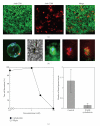Lipid rafts: keys to sperm maturation, fertilization, and early embryogenesis
- PMID: 21490798
- PMCID: PMC3068481
- DOI: 10.1155/2011/264706
Lipid rafts: keys to sperm maturation, fertilization, and early embryogenesis
Abstract
Cell membranes are composed of many different lipids and protein receptors, which are important for regulating intracellular functions and cell signaling. To orchestrate these activities, the cell membrane is compartmentalized into microdomains that are stably or transiently formed. These compartments are called "lipid rafts". In gamete cells that lack gene transcription, distribution of lipids and proteins on these lipid rafts is focused during changes in their structure and functions such as starting flagella movement and membrane fusion. In this paper, we describe the role of lipid rafts in gamete maturation, fertilization, and early embryogenesis.
Figures



Similar articles
-
The ins and outs of lipid rafts: functions in intracellular cholesterol homeostasis, microparticles, and cell membranes: Thematic Review Series: Biology of Lipid Rafts.J Lipid Res. 2020 May;61(5):676-686. doi: 10.1194/jlr.TR119000383. Epub 2020 Nov 7. J Lipid Res. 2020. PMID: 33715815 Free PMC article. Review.
-
[Cholesterol and lipid rafts in the biological membranes. Role in the release, reception and ion channel functions].Usp Fiziol Nauk. 2013 Jan-Mar;44(1):17-38. Usp Fiziol Nauk. 2013. PMID: 23662472 Review. Russian.
-
Lipids as targeting signals: lipid rafts and intracellular trafficking.Traffic. 2004 Apr;5(4):247-54. doi: 10.1111/j.1600-0854.2004.0181.x. Traffic. 2004. PMID: 15030566 Review.
-
Organization of Membrane Rafts in Chicken Sperm.J Poult Sci. 2016 Jul 25;53(3):233-239. doi: 10.2141/jpsa.0150160. J Poult Sci. 2016. PMID: 32908389 Free PMC article.
-
Immunocontraceptive target repertoire defined by systematic identification of sperm membrane alloantigens in a single species.PLoS One. 2018 Jan 17;13(1):e0190891. doi: 10.1371/journal.pone.0190891. eCollection 2018. PLoS One. 2018. PMID: 29342175 Free PMC article.
Cited by
-
Cholesterol depletion disorganizes oocyte membrane rafts altering mouse fertilization.PLoS One. 2013 Apr 25;8(4):e62919. doi: 10.1371/journal.pone.0062919. Print 2013. PLoS One. 2013. PMID: 23638166 Free PMC article.
-
Lipid dynamics in boar sperm studied by advanced fluorescence imaging techniques.Eur Biophys J. 2016 Mar;45(2):149-63. doi: 10.1007/s00249-015-1084-z. Epub 2015 Oct 19. Eur Biophys J. 2016. PMID: 26481472
-
CD81 and CD9 work independently as extracellular components upon fusion of sperm and oocyte.Biol Open. 2012 Jul 15;1(7):640-7. doi: 10.1242/bio.20121420. Epub 2012 May 21. Biol Open. 2012. PMID: 23213457 Free PMC article.
-
Impact of glycosylation on the unimpaired functions of the sperm.Clin Exp Reprod Med. 2015 Sep;42(3):77-85. doi: 10.5653/cerm.2015.42.3.77. Epub 2015 Sep 30. Clin Exp Reprod Med. 2015. PMID: 26473106 Free PMC article. Review.
-
Sterols in spermatogenesis and sperm maturation.J Lipid Res. 2013 Jan;54(1):20-33. doi: 10.1194/jlr.R032326. Epub 2012 Oct 23. J Lipid Res. 2013. PMID: 23093550 Free PMC article. Review.
References
-
- Brown DA, Rose JK. Sorting of GPI-anchored proteins to glycolipid-enriched membrane subdomains during transport to the apical cell surface. Cell. 1992;68(3):533–544. - PubMed
-
- Tanphaichitr N, Smith J, Mongkolsirikieart S, Gradil C, Lingwood CA. Role of a gamete-specific sulfoglycolipid immobilizing protein on mouse sperm-egg binding. Developmental Biology. 1993;156(1):164–175. - PubMed
-
- Maehashi E, Sato C, Ohta K, et al. Identification of the sea urchin 350-kDa sperm-binding protein as a new sialic acid-binding lectin that belongs to the heat shock protein 110 family: implication of its binding to gangliosides in sperm lipid rafts in fertilization. Journal of Biological Chemistry. 2003;278(43):42050–42057. - PubMed
-
- Toshimori K. Introduction. In: Korf HW, editor. Dynamics of the Mammalian Sperm Head. Vol. 204. New York, NY, USA: Springer; 2009. pp. 5–6. (Advances in Anatomy, Embryology and Cell Biology). - PubMed
LinkOut - more resources
Full Text Sources

